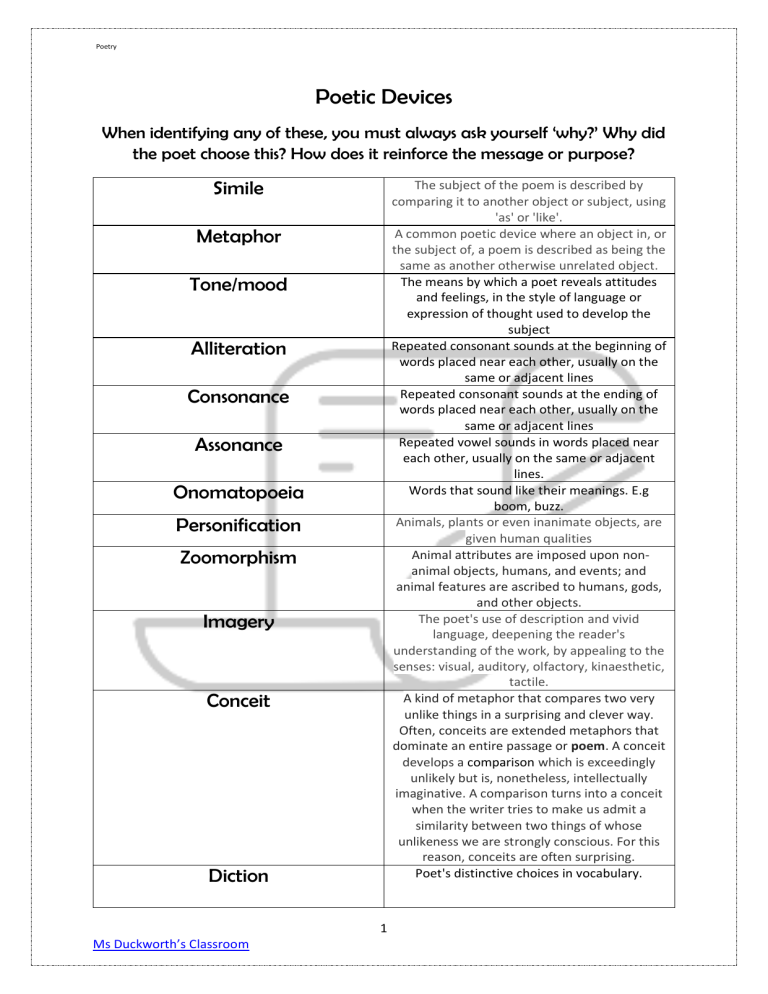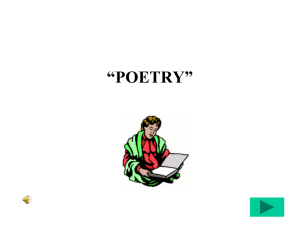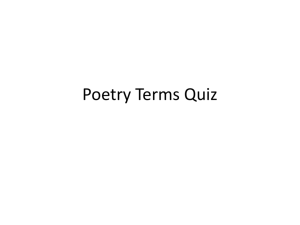
Poetry Poetic Devices When identifying any of these, you must always ask yourself ‘why?’ Why did the poet choose this? How does it reinforce the message or purpose? Simile The subject of the poem is described by comparing it to another object or subject, using 'as' or 'like'. A common poetic device where an object in, or the subject of, a poem is described as being the same as another otherwise unrelated object. The means by which a poet reveals attitudes and feelings, in the style of language or expression of thought used to develop the subject Repeated consonant sounds at the beginning of words placed near each other, usually on the same or adjacent lines Repeated consonant sounds at the ending of words placed near each other, usually on the same or adjacent lines Repeated vowel sounds in words placed near each other, usually on the same or adjacent lines. Words that sound like their meanings. E.g boom, buzz. Animals, plants or even inanimate objects, are given human qualities Animal attributes are imposed upon nonanimal objects, humans, and events; and animal features are ascribed to humans, gods, and other objects. The poet's use of description and vivid language, deepening the reader's understanding of the work, by appealing to the senses: visual, auditory, olfactory, kinaesthetic, tactile. A kind of metaphor that compares two very unlike things in a surprising and clever way. Often, conceits are extended metaphors that dominate an entire passage or poem. A conceit develops a comparison which is exceedingly unlikely but is, nonetheless, intellectually imaginative. A comparison turns into a conceit when the writer tries to make us admit a similarity between two things of whose unlikeness we are strongly conscious. For this reason, conceits are often surprising. Poet's distinctive choices in vocabulary. Metaphor Tone/mood Alliteration Consonance Assonance Onomatopoeia Personification Zoomorphism Imagery Conceit Diction 1 Ms Duckworth’s Classroom Poetry Cacophony A discordant series of harsh, unpleasant sounds helps to convey disorder. This is often furthered by the combined effect of the meaning and the difficulty of pronunciation. A series of musically pleasant sounds, conveying a sense of harmony and beauty to the language. A word, line or phrase that is repeated within the lines or stanzas of the poem itself. A pause that comes at the end of a syntactic unit (sentence, clause, or phrase). This pause can be expressed in writing as a punctuation mark A rhythmical pause in a poetic line or a sentence. It often occurs in the middle of a line, or sometimes at the beginning and the end. At times, it occurs with punctuation; at other times it does not. The continuation of the logical sense — and therefore the grammatical construction — beyond the end of a line of poetry The purposeful re-use of words and phrases for an effect. Repetition of longer phrases that include a different keyword each time. A literary technique in which two or more ideas, places, characters, and their actions are placed side by side to highlight differences A brief reference to some person, historical event, work of art, or Biblical or mythological situation or character that may not be directly named. Speaking directly to a real or imagined listener or inanimate object; addressing that person or thing by name. Any figure of speech that was once clever and original but through overuse has become outdated. When looking at a word - its implications and associations apart from its literal meaning Closely arranged things with strikingly different characteristics Deliberately representing something as less important than it really is An understatement, used to lessen the effect of a statement; substituting something innocuous for something that might be offensive or hurtful. An outrageous exaggeration used for effect Euphony Refrain End stopped line Caesura Enjambment Repetition Parallelism Juxtaposition Allusion Apostrophe Cliché Connotation Contrast Understatement Euphemism Hyperbole 2 Ms Duckworth’s Classroom Poetry Colloquial Language Words or phrases that are native to a region, country or demographic. A contradictory statement or situation to reveal a reality different from what appears to be true. A combination of two words that appear to contradict each other. A statement in which a seeming contradiction may reveal an unexpected truth. An ordinary object, event, animal, or person to which we have attached extraordinary meaning and significance A regular pattern of accented syllables separated by unaccented syllables. Rhythm helps to distinguish poetry from prose. Words that have different beginning sounds but whose endings sound alike, including the final vowel sound and everything following it Occurs within lines e.g ‘Once upon a midnight dreary, while I pondered, weak and weary’ It is also called an “imperfect rhyme,” “slant rhyme,” “near rhyme,” or “oblique rhyme.” Words that sound similar but do not rhyme exactly. E.g ‘hold’ and ‘bald’ The pattern established by the arrangement of rhymes in a stanza or poem, generally described by using letters of the alphabet to denote the recurrence of rhyming lines Meter is a stressed and unstressed syllabic pattern. The basic metrical unit which consists of one accented syllable plus one or two unaccented syllables. Kinds of feet: Iambic, Trochaic, Anapestic, Dactylic, and Spondaic A couplet is a pair of lines in a poem which have both the same rhythm (meter) and that rhyme. Irony Oxymoron Paradox Symbol Rhythm Rhyme Internal Rhyme Half Rhyme Rhyme Scheme Foot & Meter Rhyming Couplet Stanza and Stanza forms couplet (2), tercet (3), quatrain (4), quintet (5), sestet (6), septet (7), and octave (8). In addition, a stanza may follow a rhythm and rhyme pattern. 3 Ms Duckworth’s Classroom Poetry Form Blank Verse Free verse Unrhymed iambic pentameter Lines with no prescribed pattern or structure — the poet determines all the variables as seems appropriate for each poem A pair of lines, usually rhymed; this is the shortest stanza A pair of rhymed lines in iambic pentameter Couplet Heroic Couplet Fixed Form A poem which follows a set pattern of meter, rhyme scheme, stanza form, and refrain A narrative poem written as a series of quatrains in which lines of iambic tetrameter alternate with iambic trimeter with an xaxa, xbxb rhyme scheme with frequent use of repetition and often including a refrain. The “story” of a ballad can be a wide range of subjects but frequently deals with folklore or popular legends. They are written in a straightforward manner, seldom with detail, but always with graphic simplicity and force. Lyric verse is the most frequently used modern form, including all poems in which the speaker’s ardent expression of a (usually single) emotional element predominates. Ranging from complex thoughts to the simplicity of playful wit, the melodic imagery of skillfully written lyric poetry evokes in the reader’s mind the recall of similar emotional experiences More complex than the lyric, with intricate rhyme schemes and irregular number of lines, generally of considerable length, always written in a style marked by a rich, intense expression of an elevated thought praising a person or object. a poem consisting of five 3-line stanzas followed by a quatrain and having only two rhymes. In the stanzas following the first stanza, the first and third lines of the first stanza are repeated alternately as refrains. They are the final two lines of the concluding quatrain. A fourteen line poem in iambic pentameter with a prescribed rhyme scheme; its subject was traditionally love. A style of sonnet used by Shakespeare with a rhyme scheme of abab cdcd efef gg A form of sonnet made popular by Petrarch with a rhyme scheme of abbaabba cdecde or cdcdcd Ballad Lyric Ode Villanelle Sonnet Shakespearean Sonnet Petrarchan Sonnet 4 Ms Duckworth’s Classroom Poetry Dramatic Monologue A poem in which an imagined speaker addresses a silent listener. A poem written in the form of a speech of an individual character; it compresses into a single vivid scene a narrative sense of the speaker’s history and psychological insight into his character. 5 Ms Duckworth’s Classroom






